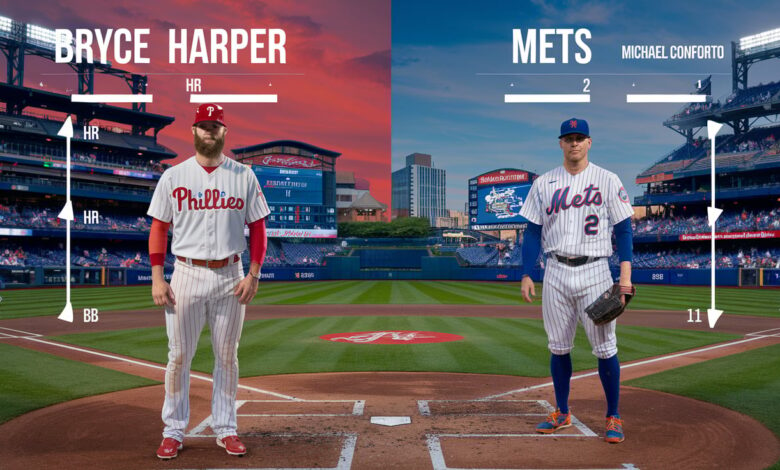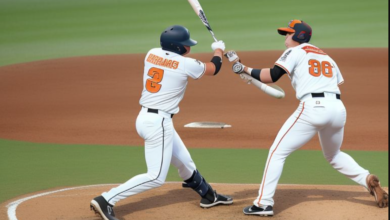Phillies vs Mets Match Player Stats: A Comprehensive Analysis

Introduction to the Phillies vs Mets Rivalry
The rivalry between the Philadelphia Phillies vs Mets Match Player Stats is a prominent feature in Major League Baseball (MLB), characterized by fierce competition and a history that dates back to the 1960s. This rivalry has not only contributed to the competitive spirit within the National League but has also fostered passionate fan engagement and memorable moments over the decades. As both teams compete in the National League East division, the stakes tend to be high, particularly when considering playoff implications and the fight for division standings.
The Phillies and Mets have faced off in numerous thrilling contests that have had significant implications for both teams’ seasons. Historically, the match-up has seen fluctuations in dominance, with various phases of strong performances from both sides. The intensity of competition is further amplified by the proximity of the cities and the loyal fanbases supporting each team. These factors contribute to the high-pressure atmosphere often witnessed during their games, making the Phillies vs Mets match player stats particularly interesting for fans and analysts alike.
Understanding the nuances behind these player statistics can provide insights into the strategies employed by each team, while also highlighting key players’ performances that define individual games and series. The statistics reveal patterns that could predict future outcomes, thus enhancing the viewing experience of the rivalry. Analyzing the player stats in the context of past match-ups serves to underscore the spirited competition between the Phillies and Mets, making it clear why this rivalry is one of the most watched and anticipated in MLB history. With each season bringing new storylines and twists, the context around the Phillies vs Mets match continues to evolve, underscoring the importance of both teams’ player performances in shaping the dynamics of this classic rivalry.
Key Players to Watch in the Match-Up
As the Phillies prepare to face the Mets, several key players will be instrumental in determining the outcome of the match. Both teams possess formidable rosters, but focusing on standout performers can provide insights into their expected impact. For the Phillies, Bryce Harper continues to be a pivotal figure. With his combination of power, speed, and on-base skill, Harper has consistently been a threat at the plate. His performance against the Mets has often been impressive, contributing to significant victories in previous encounters. Observing Harper’s current form could provide a glimpse into the potential success of the Phillies in this crucial match-up.
On the other hand, the Mets’ ace, Jacob deGrom, represents another key player to watch closely. Known for his devastating fastball and remarkable strikeout ability, deGrom has historically excelled against the Phillies. The way he handles the Phillies’ lineup could determine the trajectory of the game. His capacity to dominate batters with precision and pace makes him a player that cannot be overlooked when examining the phillies vs mets match player stats.
Additionally, players like J.T. Realmuto for the Phillies and Pete Alonso for the Mets could also play significant roles. Realmuto’s defensive prowess combined with his batting capabilities makes him a dual threat. Similarly, Alonso’s power-hitting is vital for the Mets; his past performances indicate he can change the tide of a game with a single swing. Overall, analyzing these key players provides a deeper understanding of how their performances might influence the match dynamics. As the teams gear up for this exciting showdown, keeping an eye on these players can shed light on potential strategies and outcomes.
Breaking Down Batting Stats
When analyzing the Phillies vs Mets match player stats, it is paramount to examine the batting statistics of key players on both teams. A comprehensive look at metrics such as batting average, on-base percentage (OBP), and slugging percentage (SLG) provides a clear representation of player performance and capability.
The batting average is one of the most recognizable indicators of a player’s hitting proficiency. Typically, a higher batting average reflects a player’s ability to connect with the ball consistently. For instance, if we consider players like Bryce Harper from the Phillies and Pete Alonso from the Mets, their batting averages can offer insights into their recent performances. In highly competitive matchups, each player’s average can drastically affect their teams’ run production.
On-base percentage is another critical metric that reflects a player’s ability to reach base through hits, walks, or being hit by a pitch. This statistic is especially important in the context of strategies for the Phillies vs Mets matchup. A player with a high OBP, such as Jean Segura for the Phillies or Francisco Lindor for the Mets, can significantly influence the flow of the game and create scoring opportunities for the team.
Finally, slugging percentage provides a deeper look into a player’s power-hitting ability, allowing teams to assess who can effectively convert opportunities into runs. Power hitters like Kyle Schwarber and Mark Canha can sway a game with their ability to hit for both average and power. By comparing these statistics between the two teams, we can derive which players may hold the advantage in crucial moments during the game.
Overall, analyzing these batting statistics in the context of the Phillies vs Mets match player stats equips fans and analysts alike with the necessary understanding of each team’s strengths and weaknesses at the plate.
Analyzing Pitching Performances
The pitching match-up can significantly influence the outcome of any game, particularly in high-stakes confrontations like the Phillies vs Mets clash. To understand the impact of individual pitchers, key statistics such as earned run average (ERA), walks plus hits per inning pitched (WHIP), and strikeout rates must be thoroughly analyzed. These metrics not only reflect a pitcher’s effectiveness but also provide insight into the overall performance of the team’s pitching staff.
ERA is an essential measure, as it indicates the average number of earned runs a pitcher allows over nine innings. Lower ERA values generally signify better pitching performances. For instance, if the Philadelphia Phillies’ ace boasts a sub-3.00 ERA, this may suggest he can neutralize the Mets’ offensive threats effectively, making him a critical factor in the game’s outcome. Conversely, should a Mets pitcher show an ERA exceeding 4.50, this could raise concerns about his ability to limit scoring opportunities from the powerful Phillies’ lineup.
WHIP is another pivotal statistic to consider. It is calculated by adding the number of walks and hits allowed by a pitcher, then dividing by the total innings pitched. A lower WHIP figure indicates a tighter performance on the mound. For example, if a key Phillies reliever has a WHIP under 1.20, it suggests that he consistently minimizes traffic on the bases, thereby heightening his team’s chances of emerging victorious in a close match-up.
Moreover, strikeout rates provide further context. Pitchers who can generate strikeouts significantly often possess the ability to dominate hitters, leading to higher chances of shutting down opposing offenses. An analysis of the Phillies vs Mets match player stats can thus reveal how each team’s starting and relieving pitchers may dictate the tempo of the game, establishing which side has the potential edge based on these critical statistics.
Defensive Metrics and Their Impact
The defensive capabilities of a baseball team are critical determinants of success, significantly influencing the outcome of close match-ups, such as those involving the Phillies and Mets. To evaluate these capabilities, it is essential to analyze various defensive metrics, including fielding percentage, defensive runs saved, and errors committed.
Fielding percentage serves as a primary measure of a team’s defensive effectiveness. It is calculated by dividing the total number of successful plays by the total number of chances, combining both putouts and errors. A higher fielding percentage indicates greater reliability in converting opportunities into outs. For the Phillies vs Mets match, analyzing each team’s fielding percentage can shed light on their defensive prowess and potential weaknesses that could be exploited by the opposing team.
Another valuable metric is defensive runs saved (DRS), which quantifies the impact of a team’s defense by assessing how many runs were saved compared to a league-average defense. This statistic takes into account not only errors but also the ability to field balls in play and make accurate throws. When looking at the Phillies vs Mets match player stats, DRS can reveal which team has a superior defensive unit and how that could affect the flow of the game, particularly in high-pressure situations where every run counts.
Errors committed provide further insight into a team’s defensive reliability. High error rates can lead to unearned runs, which often tilt the outcome in favor of the opposing team. By examining the frequency and nature of errors made by players during matchups, analysts can identify potential game-changing moments. Therefore, understanding the defensive metrics associated with both teams is key to forecasting how effectively they can respond to the challenges presented during the Phillies vs Mets match.
Recent Form and Head-to-Head Matchup Trends
The Philadelphia Phillies and the New York Mets have engaged in numerous matchups throughout their histories, with each team displaying fluctuating forms. Analyzing their recent performances is essential for understanding their current standings and predicting future outcomes. In the past season, the Phillies demonstrated a commendable turnaround, securing several vital wins that boosted their morale. Their offensive lineup, featuring reliable heavy hitters, has significantly contributed to their success, particularly during crucial series. Meanwhile, the Mets have faced challenges that impacted their performance, marked by inconsistent pitching and a series of unfortunate injuries affecting key players. This trend has resulted in mixed outcomes in their latest games, casting doubt on their ability to capitalize against formidable opponents.
When scrutinizing the head-to-head statistics, notable patterns emerge. Historical data indicate that the Phillies have often had the upper hand in their encounters with the Mets, particularly during home games. This home advantage is underscored by fan support, which can energize the team and affect the psyche of the visiting Mets. Conversely, the Mets have shown resilience in certain away games, pulling off surprising victories when least expected. The rivalry has produced tight contests, with games frequently decided by a narrow margin, emphasizing the competitive spirit between the two sides.
Looking ahead to future matchups, analyzing these recent forms and head-to-head statistics is crucial for enthusiasts and analysts alike. The phillies vs mets match player stats could indicate how well each team is likely to perform; hence, monitoring player conditions and past performances will be vital. By focusing on individual player contributions within these contexts, we can draw more nuanced conclusions that provide insights into how each team may fare in their upcoming encounters.
Injury Reports and Lineup Changes
In the world of baseball, injury reports carry significant weight as they can substantially alter a team’s dynamics, particularly during matchups such as the anticipated Phillies vs Mets clash. Analyzing player health is crucial in evaluating overall performance, with injuries potentially sidelining key players and affecting team strategy. In the context of the Phillies and Mets, various factors must be considered when examining the potential impact of injuries on match player stats.
For the Philadelphia Phillies, recent injury reports have indicated concerns regarding key players, such as their starting pitcher and a crucial outfielder. These injuries not only affect the on-field performance of the individuals involved but also influence the overall team strategy. The Phillies may need to adjust their lineup, possibly incorporating less experienced players, which can lead to fluctuations in their performance metrics. Enhancement of the depth chart will be necessary, and fans should be keenly aware of any last-minute changes leading up to the game.
Meanwhile, the New York Mets have faced their share of injury woes as well. Their star first baseman has been recovering from a nagging injury, leading to questions regarding his availability during the upcoming matchup against the Phillies. Additionally, changes in the bullpen may arise if any pitchers are recuperating from previous strains. Such adjustments have the potential to influence the statistical output during the game, as substitutions can lead to varying match situational outcomes.
By closely monitoring the injury updates and lineup changes for both teams, analysts and fans alike can gain valuable insights into how these factors may affect the anticipated performance displayed in the players’ statistics. Ultimately, understanding the implications of health and roster adjustments is vital when analyzing the probabilities behind the Phillies vs Mets match player stats.
Fan Engagement and Game Atmosphere
The rivalry between the Philadelphia Phillies and the New York Mets is one of the most intense in Major League Baseball, manifested not only in the players’ performances but also in the vibrant atmosphere that envelops their games. Attendance figures at these matchups represent a significant draw for fans, as these two teams consistently attract large crowds. The energy in the stadium is palpable, and it plays a crucial role in the dynamics of the Phillies vs Mets matches.
Home games typically witness elevated attendance rates, which can significantly enhance player performance. Players often display heightened levels of energy and focus when supported by a fervent home crowd. Conversely, the Mets and Phillies are known to travel well, with fans often filling the opposing stadium, thereby creating an exhilarating and sometimes hostile environment for visiting players. This duality of support and rivalry transforms each matchup into a thrilling spectacle, characterized by emotional highs and lows.
Moreover, fan engagement extends beyond the ballpark, particularly through social media platforms. Both teams maintain a robust online presence where fans discuss past performances, share their thoughts on player stats, and predict outcomes of upcoming games. During key matchups, such as Phillies vs Mets games, social media buzz escalates, making it an essential space for fans to connect and engage with each other. Statistics regarding player performances are frequently shared and analyzed during these discussions, contributing to a culture of informed fandom that enhances the overall match experience.
The combined effect of enthusiastic attendance and active online engagement shapes the atmosphere surrounding the Phillies vs Mets contests, thus influencing not just fan experience but also the players’ outputs on the diamond. This captivating interplay between fans and players underlines the importance of the crowd’s support in high-stakes matchups, ultimately adding layers of excitement and anticipation to each game.
Conclusion: Implications of Player Stats on Future Games
The analysis of player statistics from the Phillies vs Mets match-ups provides valuable insights that can inform future games between these two teams. The intricate rivalry showcased through their past performances reveals trends and patterns critical to understanding the dynamics of upcoming matches. For example, analyzing batting averages, on-base percentages, and pitching efficiencies offer a quantitative basis on which managers can base strategies and lineups.
Moreover, individual player statistics, such as strikeouts, home runs, and earned run averages, serve not only as indicators of current form but also as predictors of potential future success. By evaluating these metrics in the context of player matchups, we can gain a clearer picture of which players are likely to thrive and which may struggle in specific game scenarios. This analytical approach strengthens the competitive edge expected in the Phillies vs Mets rivalry as teams often adjust their tactics based on historical player stats and projected match-up outcomes.
Furthermore, understanding how players have historically performed against their rivals can foster deeper engagement for fans and analysts alike. This knowledge may influence betting lines, ticket sales, and viewership, as both sets of supporters weigh the implications of these statistics on upcoming games. The ever-evolving narrative of the Phillies and Mets games, fueled by historical player data, ensures sustained interest in the outcomes and statistics surrounding each encounter.
As each season unfolds, keeping track of player performances and their stats will be essential for both teams. Observers should remain attentive to how these player metrics influence coaching decisions, roster changes, and overall team performance in this storied rivalry. Ultimately, the pursuit of statistical excellence in the Phillies vs Mets match-up is not just about numbers; it’s about the stories and predictions that emerge from them.
You May Also Read This Skyrix.



